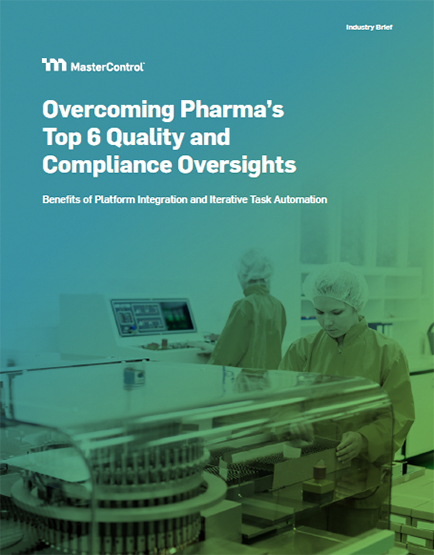
PROCESSING. PLEASE WAIT...


White Paper: MasterControl
Overcoming Pharma’s Top 6 Quality and Compliance Oversights
Benefits of Platform Integration and Iterative Task Automation
For companies doing business in the heavily regulated pharmaceutical industry, quality management and compliance are not just intimidating endeavors — they involve activities that are increasing in complexity as the industry accelerates. Quality successes can only be achieved in the modern regulatory environment when an extensive range of variables are continually monitored and appropriately handled. The prevention of quality oversights — whether they occur during document control activities, corrective action/preventive action (CAPA) management, audit initiatives, supplier relationships, or any other quality-related process — demands precise actions, informed decision-making, and connected processes, all of which can only be realistically achieved in accordance with regulatory requirements by using purpose-built digital solutions.
Avoiding Quality and Compliance Oversights
This brief presents six common quality and compliance missteps that pharma companies either inadvertently enable or unknowingly perpetuate over time. It also recommends actions organizations can take today to help mitigate the long-and short-term problems caused by each oversight.
Oversight #1: Failure to Adapt to Regulators’ Risk-Based Approach to Quality
Over the past decade, the regulations and standards that affect pharmaceutical companies have been trending toward a greater focus on risk management and risk-based thinking, a shift that has undoubtedly been accelerated by the COVID-19 pandemic. With each update to an existing standard or new regulation that goes into effect, regulatory agencies are placing more emphasis on risk management and mitigation. Regulators across the globe are shifting from what was once a one-size-fits-all regulatory mentality to a more segmented approach that is primarily driven by data. This compliance trend is expected to become more prevalent, as indicated by the U.S. Food and Drug Administration (FDA) Q9 Quality Risk Management guidance which specifies that greater assurance of a company’s ability to deal with potential risks “might affect the extent and level of direct regulatory oversight.”i
As the role of good quality data (and auditors’ access to it) becomes increasingly vital to the enforcement of regulatory policies, effective risk management is emerging as the cornerstone of compliance. But risk-based quality management isn’t just important for compliance reasons — it is essential for neutralizing the effects (and potential effects) of quality events that commonly occur in pharma environments.


 2025 All Rights Reserved | by: www.ciowhitepapersreview.com
2025 All Rights Reserved | by: www.ciowhitepapersreview.com